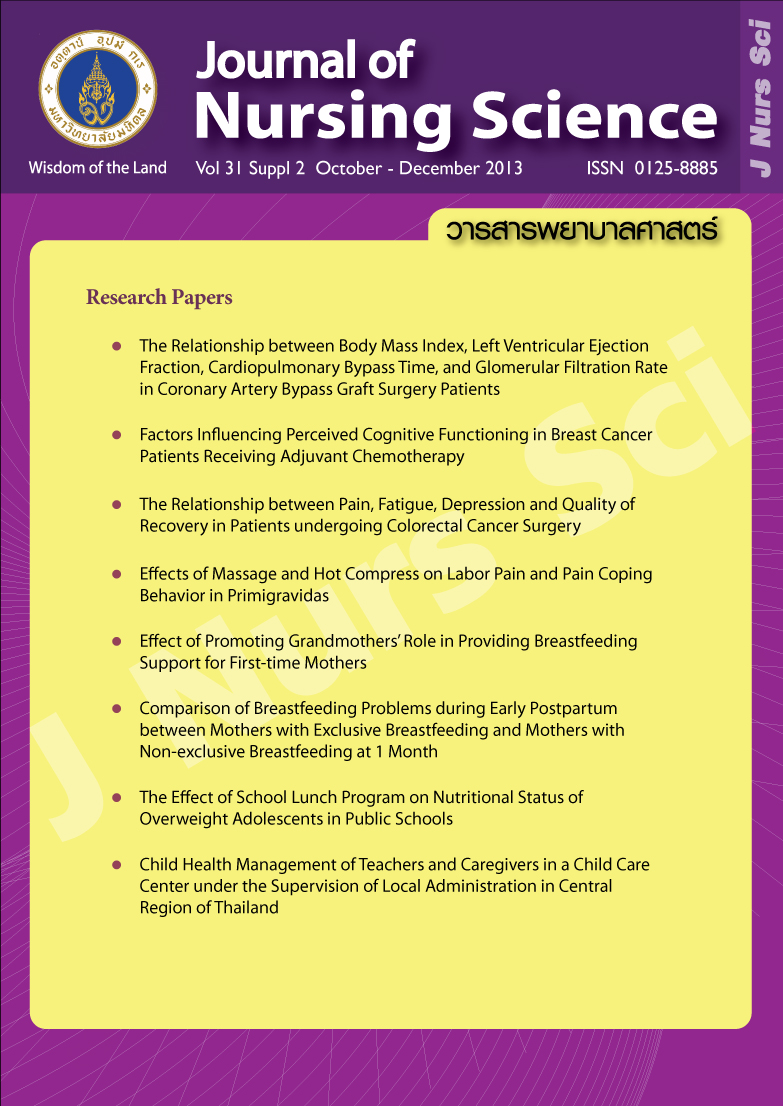Comparison of Breastfeeding Problems during Early Postpartum between Mothers with Exclusive Breastfeeding and Mothers with Non-exclusive Breastfeeding at 1 Month
Main Article Content
Abstract
Purpose: This study aimed to investigate breastfeeding problems during the first three days postpartum and compare breastfeeding problems and breast milk supply during the first three days postpartum between mothers with exclusive breastfeeding and non-exclusive breastfeeding at 1 month.
Design: Descriptive design.
Methods: A secondary data analysis was conducted from a sample of 50 postpartum mothers who had insufficient breast milk supply in 24 hours, normal nipples, no complications, and were rooming-in with their normal term newborns with no tongue-tie. Thirty eight of them were exclusive breastfeeding and twelve of them were non-exclusive breastfeeding at 1 month postpartum. Descriptive statistics, t-test, Mann-Whitney U test, Chi square, and content analysis were used for data analysis.
Main findings: The findings revealed that the proportions of mothers who had the problems of “inadequate sleep”, “baby cry and awake frequently”, “unsure to be able to breastfeed” during the first 3 days in mothers with exclusive breastfeeding was significantly less than the proportions of mothers with non-exclusive breastfeeding at 1 month postpartum (p = .013, .010, .002 respectively). However, the proportion of mothers who had the problem of “perceived inadequate breast milk supply” between the two groups was not significantly different (p = .063). Breast milk supply on the 3rd day postpartum of mothers with exclusive breastfeeding was greater than that of mothers with non-exclusive breastfeeding at 1 month postpartum (p < .001).
Conclusion and recommendations: Nurses and midwives should help mothers to rest during the first three days postpartum, and gain confidence to breastfeed their newborns.
การเปรียบเทียบปัญหาการเลี้ยงลูกด้วยนมแม่ใน 3 วันแรกหลังคลอดระหว่างมารดาที่เลี้ยงลูกด้วยนมแม่อย่างเดียวกับมารดาที่เลี้ยงลูกด้วยนมแม่และนมผสม เมื่อ 1 เดือน
วรรณา พาหุวัฒนกร, มารยาท สุธรรมพิทักษ์
บทคัดย่อ
วัตถุประสงค์: เพื่อเปรียบเทียบปัญหาการเลี้ยงลูกด้วยนมแม่และปริมาณน้ำนมแม่ใน 3 วันแรกหลังคลอดระหว่างมารดาที่เลี้ยงลูกด้วยนมแม่อย่างเดียวกับมารดาที่เลี้ยงลูกด้วยนมแม่และนมผสม เมื่อ 1 เดือนหลังคลอด
รูปแบบการวิจัย: การวิจัยเชิงบรรยาย
วิธีดำเนินการวิจัย: วิเคราะห์ข้อมูลทุติยภูมิจากมารดาหลังคลอด 50 คน เป็นมารดาที่ไม่มีน้ำนม 24 ชั่วโมงแรก ไม่มีภาวะแทรกซ้อนหลังคลอด และไม่มีปัญหาหัวนม ย้ายมาหน่วยหลังคลอดพร้อมทารกแรกเกิดปกติครบกำหนด ไม่มีพังผืดใต้ลิ้น ซึ่งเป็นมารดาเลี้ยงลูกด้วยนมแม่อย่างเดียว 38 คน และเลี้ยงลูกด้วยนมแม่และนมผสม 12 คน เมื่อ 1 เดือนหลังคลอด สถิติที่ใช้ในการวิเคราะห์ข้อมูล ได้แก่ ความถี่ ร้อยละ สถิติที Mann-Whitney U Test ไคสแควร์และการวิเคราะห์เชิงเนื้อหา
ผลการวิจัย: สัดส่วนของมารดาที่มีปัญหา “พักผ่อนน้อย” “ลูกร้องกวนและตื่นบ่อย” และ “ไม่แน่ใจว่าจะเลี้ยงลูกด้วยนมแม่ได้” ใน 3 วันแรกหลังคลอดในมารดาที่เลี้ยงลูกด้วยนมแม่อย่างเดียวน้อยกว่ามารดาที่เลี้ยงลูกด้วยนมแม่และนมผสมเมื่อ 1 เดือนหลังคลอด อย่างมีนัยสำคัญทางสถิติ (p = .013, .010, .002 ตามลำดับ) แต่มีปัญหา “คิดว่าปริมาณน้ำนมไม่พอ” ไม่แตกต่างกัน (p = .063) มารดาที่เลี้ยงลูกด้วยนมแม่อย่างเดียว มีปริมาณน้ำนมแม่ในวันที่ 3 หลังคลอดมากกว่ามารดาที่เลี้ยงลูกด้วยนมแม่และนมผสมอย่างมีนัยสำคัญทางสถิติ (p < .001)
สรุปและข้อเสนอแนะ: พยาบาลผดุงครรภ์ควรดูแลให้มารดาได้รับการพักผ่อนในระยะ 3 วันแรกหลังคลอด และสร้างความมั่นใจในการเลี้ยงลูกด้วยนมแม่
คำสำคัญ: ปัญหาการเลี้ยงลูกด้วยนมแม่ ปริมาณน้ำนมแม่ การเลี้ยงลูกด้วยนมแม่อย่างเดียว มารดาหลังคลอด
Article Details
Copyright Notice: Nursing Science Journal of Thailand has exclusive rights to publish and distribute the manuscript and all contents therein. Without the journal’s permission, the dissemination of the manuscript in another journal or online, and the reproduction of the manuscript for non-educational purpose are prohibited.

Disclaimer: The opinion expressed and figures provided in this journal, NSJT, are the sole responsibility of the authors. The editorial board bears no responsibility in this regard.


